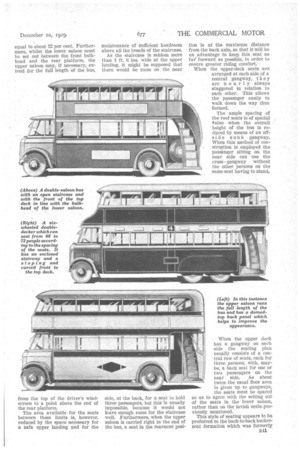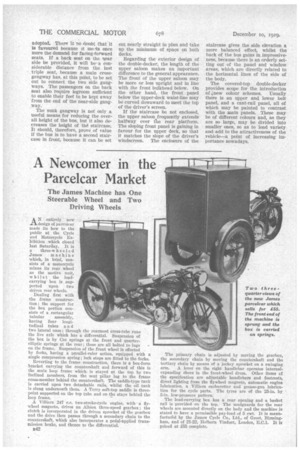Features which are Favoured in DOUBLE-DECK MOTORBUSES
Page 76

Page 77

Page 78

If you've noticed an error in this article please click here to report it so we can fix it.
METE double-deck bus, which was formerly built with a seating plan strictly following a conventional layout, is now, perhaps, more varied, from this point of view, than is any other vehicle. Nearly all the changes which have taken place during the past year or two may be traced to the enclosure of the upper deck.
When the upper deck was converted into a saloon, it was soon realized that activities in the direction of the promotion of comfort need not be confined to the provision of cushions, fully upholstered backrests and drop-windows, but special attention could be given to increasing the spacing of the seats.
Although an open upper deck may have a seating layout which provides ample space for the passengers, this feature has of late been emphasized to such an extent that the space between the seats on some upper decks is several inches more than on many long-distance coaches.
In the case of a maximum-capacity MO six-wheeler, with 68 or 70 seats, the minimum spacing of 2 ft. 3 ins, between each row of seats may nOt, to any great extent, be exceeded, but even with this class of vehicle the seats on the off side of the roof will often be 2 ft. 5 ins. apart.
The double-decker with a seating capacity for 50-52 persons is also gaining in popularity. A modern body mounted on a forward-control four-wheeled chassis and having an overall length of about 25 ft. has accommodation for 24 passengers in the lower saloon and 26 persons on the upper one.
On the upper deck some of the seats are nearly 3 ft. apart, so that the cross-gangways may still be an inch or two larger than is usual and yet the cushions are noticeably wider than they are ordinarily and there is plenty Of room for a fully upholstered and well-raked backrest. Such spacing, if used in the lower compartment, would be wide enough to permit the provision of a side door between any two rows of seats.
This arrangement of the seats is possible because the upper-deck load should not exceed that of the lower saloon by more than an amount equal to about 12 per cent. Furthersnore, whilst the lower saloon must be set out between the front bulkhead and the rear platform, the upper saloon may, if necessary, extend for the full length of the bus, from the top of the driver's windscreen to a point above the end of the rear platform.
The area available for the seats between these limits is, however, reduced by the space necessary for a safe upper landing and for the maintenance of sufficient headroom above all the treads of the staircase.
As the staircase is seldom more than 1 ft. 6 ins, wide at the upper landing, it might be supposed that there would be room on the near side, at the back, for a seat to hold three passengers, but this Is usually impossible, because it would not leave enough room for the staircase well. Furthermore, when the upper saloon is carried right to the end of the bus, a seat in the rearmost posi tion is at the maximum distance from the back axle, so that it will be an advantage to keep this seat as far' forward as possible, in order to ensure greater riding comfort.
When the upper-deck seats are arranged at each side of a central gangway, they are nearly' always staggered in relation to each other.' This allows the passenger easily to walk down the way thus formed.
The ample spacing of the roof seats is of special talue when the overall height of the bus is reduced by means of an offside sunk gangway. When this method of construction is employed the passenger sitting on the near side can use the cross gangway = without the other persons on the same seat having to stand.
When the upper deck has a gangway on each side the seating plan usually consists of a central row of seats, each for three persons, with, maybe, a back seat for one or two passengers on the near side. As about twice the usual floor area is given up to gangways, the seats must be spaced so as to agree with the setting out of the seats in the lower saloon, rather than on the lavish scalepreviously mentioned.
This style of seating appears to be preferred to the back-to-back bucketseat formation which was formerly 411.
adopted. There is no doubt that it is favoured because it me,,ts once more the demand for facing-forward seats. If a back seat on the tlear side be provided, it will be a considerable distance from the last triple seat, because a main crossgangway has, at this point, to be set out to connect the two side gangways. The passengers on the back seat also require legroom sufficient to enable their feet to be kept away from the end of the near-side gangway.
The sunk gangway is not only a useful means for reducing the overall height of the bus, but it also decreases the height of thd staircase. It should, therefore, prove of value if the bus is to have a second staircase in front, because it can be set out nearly straight in plan and take up the minimum of space on both decks.
• Regarding the exterior design of the double-decker, the length of the upper saloon makes an important difference to the general appearance. The front of the upper saloon may be more or less upright and in line with the front bulkhead below. On the other hand, the front panel below the upper-deck waist-line may be curved downward to meet the top of the driver's screen.
If the staircase be not enclosed, the upper saloon frequently extends halfway over the rear platform. The sloping front panel is gaining in favour for the upper deck, so that it matches the slope of the driver's windscreen. The enclosure of the staircase gives the side elevation a more balanced effect, whilst the back of the bus gains in impressiveness, because there is an orderly setting out of the panel and window areas, which are directly related to the horizontal lines of the side of the body.
The covered-top double-decker provides scope for the introduction of new colour schemes. Usually there is an upper and lower belt panel, and a cant-rail panel, all of which may be painted to contrast with the main panels. These may be of different colours and, as they are so large, may be divided into smaller ones, so as to lend variety and add to the attractiveness of the vehicle—a point of increasing importance nowadays.
























































































































